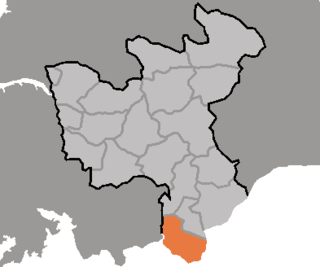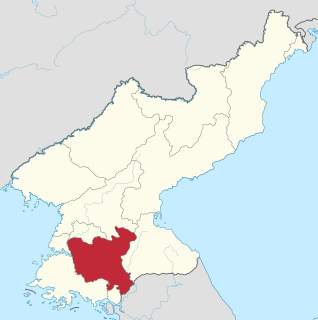Pongdong Station is a railway station located in Pongsan County, North Hwanghae province, North Korea. It is on located on the P'yŏngbu Line, which was formed from part of the Kyŏngŭi Line to accommodate the shift of the capital from Seoul to P'yŏngyang; though this line physically connects P'yŏngyang to Pusan via Dorasan, in operational reality it ends at Kaesŏng due to the Korean Demilitarized Zone.

Sonha Station is a railway station located in Kaesŏng-t'ŭkkŭpsi, North Hwanghae province, North Korea. It is on located on the P'yŏngbu Line, which was formed from part of the Kyŏngŭi Line to accommodate the shift of the capital from Seoul to P'yŏngyang; though this line physically connects P'yŏngyang to Pusan via Dorasan, in operational reality it ends at Kaesŏng due to the Korean Demilitarized Zone.
Ryŏhyŏn Station is a railway station located in Ryŏhyŏl-li, Kaep'ung County, North Hwanghae province, North Korea. It is on located on the P'yŏngbu Line, which was formed from part of the Kyŏngŭi Line to accommodate the shift of the capital from Seoul to P'yŏngyang; though this line physically connects P'yŏngyang to Pusan via Dorasan, in operational reality it ends at Kaesŏng due to the Korean Demilitarized Zone.
Kyejŏng Station is a railway station located in Kyejŏng-ri, Kŭmch'ŏn County, North Hwanghae province, North Korea. It is on located on the P'yŏngbu Line, which was formed from part of the Kyŏngŭi Line to accommodate the shift of the capital from Seoul to P'yŏngyang; though this line physically connects P'yŏngyang to Pusan via Dorasan, in operational reality it ends at Kaesŏng due to the Korean Demilitarized Zone.
Kŭmch'ŏn Station is a railway station located in Kŭmch'ŏn-ŭp, Kŭmch'ŏn County, North Hwanghae province, North Korea. It is on located on the P'yŏngbu Line, which was formed from part of the Kyŏngŭi Line to accommodate the shift of the capital from Seoul to P'yŏngyang; though this line physically connects P'yŏngyang to Pusan via Dorasan, in operational reality it ends at Kaesŏng due to the Korean Demilitarized Zone.
Hanp'o Station is a railway station located in Hanp'o-ri, P'yŏngsan County, North Hwanghae province, North Korea. It is on located on the P'yŏngbu Line, which was formed from part of the Kyŏngŭi Line to accommodate the shift of the capital from Seoul to P'yŏngyang; though this line physically connects P'yŏngyang to Pusan via Dorasan, in operational reality it ends at Kaesŏng due to the Korean Demilitarized Zone.
Taebaeksansŏng Station is a railway station in Sansŏng-ri, P‘yŏngsan County, North Hwanghae province, North Korea. It is on the P'yŏngbu Line, which was formed from part of the Kyŏngŭi Line to accommodate the shift of the capital from Seoul to P'yŏngyang. Though this line physically connects P'yŏngyang to Pusan via Dorasan, in operational reality it ends at Kaesŏng due to the Korean Demilitarized Zone.
Mulgae Station is a railway station located in P‘yŏngsan County, North Hwanghae province, North Korea. It is on located on the P'yŏngbu Line, which was formed from part of the Kyŏngŭi Line to accommodate the shift of the capital from Seoul to P'yŏngyang; though this line physically connects P'yŏngyang to Pusan via Dorasan, in operational reality it ends at Kaesŏng due to the Korean Demilitarized Zone.
Sokhyon Station is a railway station located in Sinmak-ri, Sŏhŭng Country, North Hwanghae province, North Korea. It is on located on the P'yŏngbu Line, which was formed from part of the Kyŏngŭi Line to accommodate the shift of the capital from Seoul to P'yŏngyang; though this line physically connects P'yŏngyang to Pusan via Dorasan, in operational reality it ends at Kaesŏng due to the Korean Demilitarized Zone.
Sŏhŭng Station is a railway station located in Sŏhŭng-ŭp, Sŏhŭng Country, North Hwanghae province, North Korea. It is on located on the P'yŏngbu Line, which was formed from part of the Kyŏngŭi Line to accommodate the shift of the capital from Seoul to P'yŏngyang; though this line physically connects P'yŏngyang to Pusan via Dorasan, in operational reality it ends at Kaesŏng due to the Korean Demilitarized Zone.
Munmu Station is a railway station located in Munmu-ri, Sŏhŭng County, North Hwanghae province, North Korea. It is on located on the P'yŏngbu Line, which was formed from part of the Kyŏngŭi Line to accommodate the shift of the capital from Seoul to P'yŏngyang; though this line physically connects P'yŏngyang to Pusan via Dorasan, in operational reality it ends at Kaesŏng due to the Korean Demilitarized Zone.
Hŭngsu Station is a railway station located in Hŭngsu-ri, Pongsan County, North Hwanghae province, North Korea. It is on located on the P'yŏngbu Line, which was formed from part of the Kyŏngŭi Line to accommodate the shift of the capital from Seoul to P'yŏngyang; though this line physically connects P'yŏngyang to Pusan via Dorasan, in operational reality it ends at Kaesŏng due to the Korean Demilitarized Zone.
Ch'ŏnggye Station is a railway station located in Pongsan County, North Hwanghae province, North Korea. It is on located on the P'yŏngbu Line, which was formed from part of the Kyŏngŭi Line to accommodate the shift of the capital from Seoul to P'yŏngyang; though this line physically connects P'yŏngyang to Pusan via Dorasan, in operational reality it ends at Kaesŏng due to the Korean Demilitarized Zone.
Sariwŏn Ch'ŏngnyŏn Station is the central railway station of Sariwŏn, North Hwanghae province, North Korea. It is on located on the P'yŏngbu Line, which was formed from part of the Kyŏngŭi Line to accommodate the shift of the capital from Seoul to P'yŏngyang; though this line physically connects P'yŏngyang to Pusan via Dorasan, in operational reality it ends at Kaesŏng due to the Korean Demilitarized Zone. It is also the northern terminus of the Hwanghae Ch'ŏngnyŏn Line.
Chŏngbang Station is a railway station located in Sariwŏn, North Hwanghae province, North Korea. It is on located on the P'yŏngbu Line, which was formed from part of the Kyŏngŭi Line to accommodate the shift of the capital from Seoul to P'yŏngyang; though this line physically connects P'yŏngyang to Pusan via Dorasan, in operational reality it ends at Kaesŏng due to the Korean Demilitarized Zone.
Ch'imch'on Ch'ŏngnyŏn Station (Chosŏn'gŭl: 침촌청년역) is a passenger railway station located in Ch'imch'ol-li, Hwangju County, North Hwanghae Province, North Korea. It is on located on the P'yŏngbu Line, which was formed from part of the Kyŏngŭi Line to accommodate the shift of the capital from Seoul to P'yŏngyang; though this line physically connects P'yŏngyang to Pusan via Dorasan, in operational reality it ends at Kaesŏng due to the Korean Demilitarized Zone.
Hwangju Station is a railway station in Hwangju County, North Hwanghae Province, North Korea. It is the junction point of the P'yŏngbu Line, which runs from P'yŏngyang to Kaesŏng, and the Songrim Line, which begins at Hwangju and runs to Songrim.
Kindŭng Station is a railway station in Ryonggung-ri, Hwangju County, North Hwanghae Province, North Korea. It is on located on the P'yŏngbu Line, which was formed from part of the Kyŏngŭi Line to accommodate the shift of the capital from Seoul to P'yŏngyang; though this line physically connects P'yŏngyang to Pusan via Dorasan, in operational reality it ends at Kaesŏng due to the Korean Demilitarized Zone.

The P'yŏngbu Line is an electrified standard-gauge trunk line of the Korean State Railway running from P'yŏngyang to Kaesŏng in North Korea and further south across the DMZ to Seoul in South Korea; the name comes from the two (theoretical) termini of the line: P'yŏngyang and Pusan.
East Sariwŏn Station is a railway station located in Sariwŏn, North Hwanghae province, North Korea. It is on located on the P'yŏngbu Line, which was formed from part of the Kyŏngŭi Line to accommodate the shift of the capital from Seoul to P'yŏngyang; though this line physically connects P'yŏngyang to Pusan via Dorasan, in operational reality it ends at Kaesŏng due to the Korean Demilitarized Zone.








